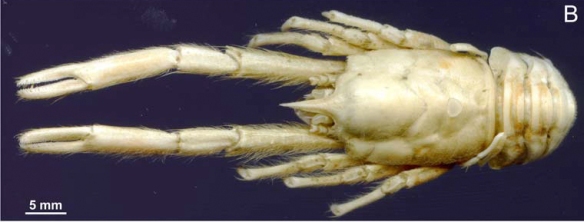
From the BBC today:
The deep-sea crab that eats trees
By Matt Walker
Editor, Earth NewsDeep under the ocean, there is a species of crab that eats trees.
The crab survives by eating wood that has sunk to the ocean floor, comprising trunks and leaves swept into the sea, as well as the odd shipwreck.
Inside the stomach of the crab, also called a squat lobster, are bacteria and fungi that help digest the wood.
The discovery, published in the journal Marine Biology, adds to evidence that these so-called ‘wood falls’ help support special underwater communities.
“At first sight, it seems improbable,” says PhD student Caroline Hoyoux of the University of Liège, Belgium.
“Munidopsis andamanica is a species only found in the deep sea and yet it eats ‘terrestrial food’,” she says.
Ms Hoyoux and colleagues based at the University of Liege and at the Natural History Museum and Pierre and Marie Curie University in Paris, France made the discovery while studying which animals colonise wood falls.
Among worms, bivalves and a host of crustacean species they found Munidopsis andamanica, a species known as a galatheid crab, or squat lobster.
Further investigation of the crabs mouthparts and gut contents revealed they feed exclusively on wood.
“We were surprised, because crustaceans are often regarded as predators or scavengers. The fact I found M. andamanica consistently feeding on vegetal remains, especially wood, instead of eating molluscs or [worms] breaks with the general a priori about the diet of squat lobsters,” says Ms Hoyoux.
Sunken treasure
The importance of wood falls and the communities they host are only just being appreciated.
Although first discovered in the late 19th century, it was not until the late 1970s that scientists began to study the animals that colonise them.
Until this century, these were mainly thought to be wood-boring molluscs.
“However, crustaceans are the second most important group, according to the number of species and individuals,” says Ms Hoyoux.
It sounds like a classic horror story – eyeless, mouthless worms lurk in the dark, settling onto dead animals and sending out green ‘roots’ to devour their bones. In fact, such worms do exist in the deep sea. They were first discovered in 2002 by researchers at the Monterey Bay Aquarium Research Institute (MBARI), who were using a robot submarine to explore Monterey Canyon. But that wasn’t the end of the story. After ‘planting’ several dead whales on the seafloor, a team of biologists recently announced that as many as 15 different species of boneworms may live in Monterey Bay alone. After years of study, the researchers have begun to piece together the bizarre story of the boneworms, all of which are in the genus Osedax: here.
ScienceDaily (Apr. 20, 2010) — An international team of scientists led by the paleontologist Steffen Kiel at the University of Kiel, Germany, found the first fossil boreholes of the worm Osedax that consumes whale bones on the deep-sea floor. They conclude that “boneworms” are at least 30 million years old: here.
Oceanic land crab extinction linked to colonization of Hawaii: here.
In the funny math of undersea biodiversity, more food means less variety among species that inhabit the muddy floors of submarine canyons: here.
Deep-sea biodiversity: open access book with 44 new taxa in 28 articles by 45 authors: here.
Phylogeny of Calyptraeotheres (Crustacea, Decapoda, Brachyura, Pinnotheridae): here.
A strange, yet compelling, picture gallery of sea anemones attempting to eat sea slugs: here.










Pingback: Deep-sea animals in the age of dinosaurs | Dear Kitty. Some blog